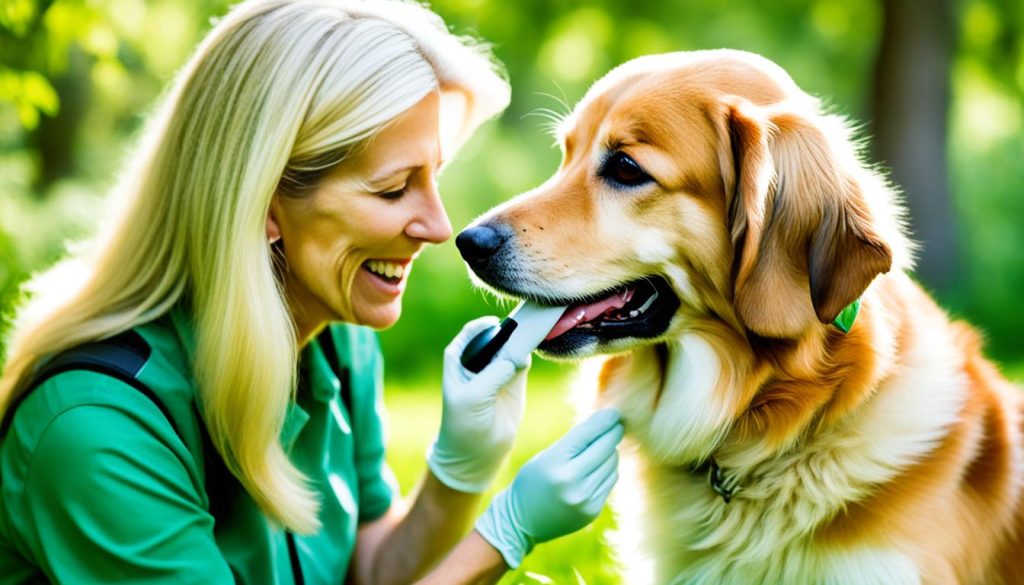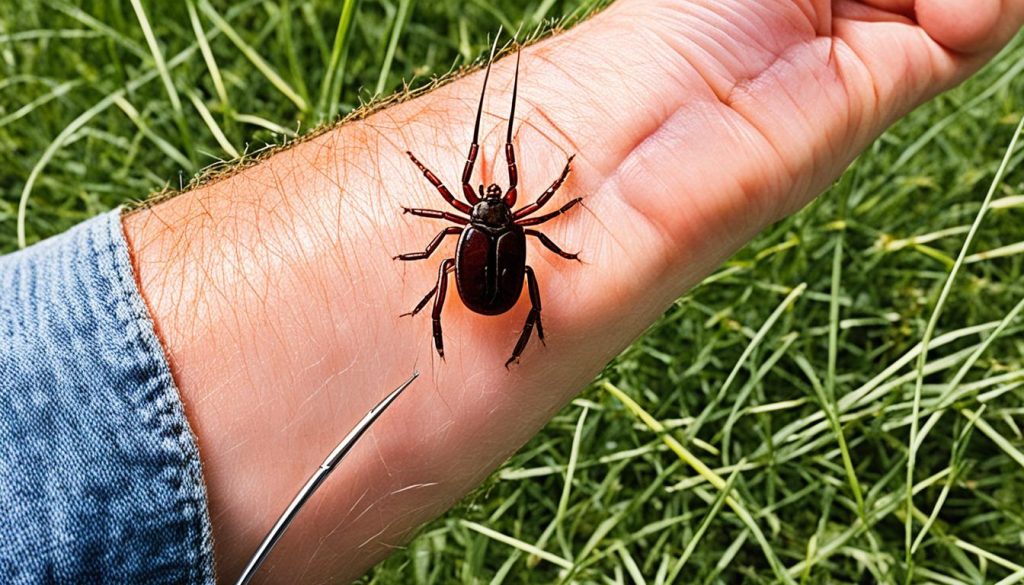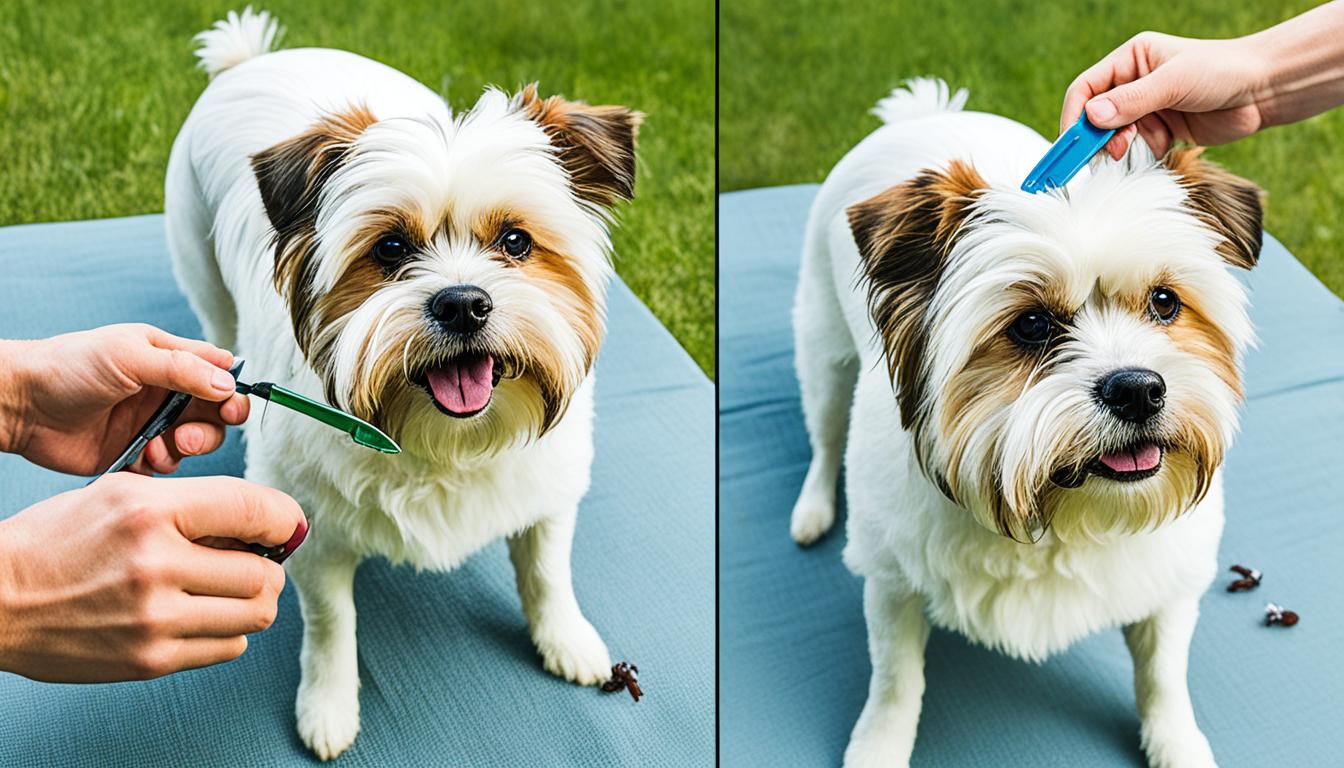Ticks are grey-brown egg-shaped, blood-sucking creepy crawlies that vary in size from 1mm to 1cm. After feeding, ticks become visible as small bumps on the dog’s skin. They often attach themselves to areas around the dog’s head, neck, ears, and feet.
Twisting off ticks using a tick-removal device is the recommended removal method to prevent infection. It’s crucial not to squeeze the tick’s body or leave its head embedded.
Tick treatment options such as spot-on treatments, tablets, and collars can help prevent tick infestation and the transmission of diseases.
How to Remove a Tick from a Dog?
When it comes to removing ticks from dogs, it is essential to do it properly to minimize the risk of infection. Here’s a step-by-step guide on how to remove ticks from your dog:
- Gently part your dog’s fur to locate the tick. Ticks are often found in areas around the dog’s head, neck, ears, and feet.
- Once you’ve located the tick, take a tick remover and push it under the tick.
- Twist the tick remover in a clockwise direction until the tick comes loose. Make sure to apply even and gentle pressure.
- Ensure that the tick is completely removed from your dog’s skin. Check carefully to make sure no parts of the tick are left behind.
Note: Avoid using vaseline or alcohol to remove ticks from your dog. These methods are often ineffective and can even cause the tick to regurgitate blood into your dog, increasing the risk of infection.
Here’s an image that illustrates the proper way to remove a tick from a dog:
Remember, proper tick removal is crucial for the well-being of your furry friend. By following these steps, you can safely and effectively remove ticks from your dog.
Signs Your Dog Has a Tick
Ticks are common parasites that can infest dogs and cause various health issues. It’s important to be able to identify the signs that your dog may have a tick to ensure early detection and prompt removal. Here are the key signs to watch out for:
- Small bumps or dark spots on the dog’s skin: After a tick has bitten a dog, it may leave behind small bumps or a small, dark spot on the skin. These bumps can be felt when running your fingers through your dog’s fur.
- Itching and discomfort: Dogs with ticks often exhibit itching, discomfort, or excessive scratching in the area where the tick is attached. They may try to bite or lick the affected area to relieve the irritation.
To have a clearer understanding of the signs your dog has a tick, refer to the visual guide below:
Visual Guide: Signs Your Dog Has a Tick
| Signs Your Dog Has a Tick | Description |
|---|---|
| Small bumps or dark spots on the dog’s skin | Visible bumps or a small spot on the skin after a tick bite |
| Itching and discomfort | Excessive scratching, licking, or biting in the affected area |
Regularly checking your dog for ticks, especially after walks in tick-infested areas, is crucial to ensure their well-being. Early detection and timely removal of ticks help prevent potential health complications.
Tick-Borne Diseases in Dogs
Ticks can transmit various diseases to dogs, including Lyme disease, babesiosis, and tick-borne encephalitis. Failing to remove a tick from a dog increases the risk of disease transmission and can lead to serious health issues. It is important to understand the potential consequences of leaving a tick attached to your dog.
Symptoms of Tick-Borne Diseases
The different tick-borne diseases can manifest in various ways in dogs. Here are some common symptoms:
- Lyme disease: Loss of appetite, lameness, fever, and swollen lymph nodes.
- Babesiosis: Pale gums, fever, and loss of appetite.
- Tick-borne encephalitis: High temperatures, weakness, seizures, and dizziness.
If you notice any of these symptoms in your dog, it is crucial to seek immediate veterinary attention for proper diagnosis and treatment.
The Importance of Tick Removal
When a tick remains attached to a dog for an extended period, it continues to feed and increases the chances of disease transmission. Removing ticks promptly helps minimize the risk of infection and other complications. Proper tick removal techniques, such as using tick removal devices, are essential to ensure the tick is completely and safely extracted.
| Disease | Symptoms |
|---|---|
| Lyme disease | Loss of appetite, lameness, fever, swollen lymph nodes |
| Babesiosis | Pale gums, fever, loss of appetite |
| Tick-borne encephalitis | High temperatures, weakness, seizures, dizziness |
The Importance of Veterinary Care
While prompt tick removal is crucial, it is equally important to consult a veterinarian after a tick bite. A vet can provide proper diagnosis and recommend any necessary treatment or preventive measures. Professional guidance is essential to ensure your dog’s well-being and reduce the risk of tick-borne diseases.
Tick Prevention for Dogs
Tick prevention is crucial in safeguarding your dog against tick infestations and the potential diseases they carry. Utilizing tick treatments that repel or eliminate ticks is highly recommended, particularly in areas where ticks are prevalent.
There are various tick prevention options available for dogs:
- Spot-on treatments: These are applied directly to your dog’s skin, usually between the shoulder blades. They provide long-lasting protection against ticks.
- Tablets: Oral medications can help repel ticks and control infestations. These tablets are typically given monthly and work systemically throughout your dog’s body.
- Collars: Tick preventative collars are worn around your dog’s neck. They release active ingredients that repel ticks and often provide protection for several months.
Consulting your veterinarian is essential in determining the most suitable tick prevention method for your dog. They can evaluate your dog’s specific needs and recommend the most effective product.
Be sure to carefully follow the instructions provided with tick treatments. Failure to do so may reduce their effectiveness or result in accidental ingestion by other pets, such as cats. Some tick treatments for dogs can be lethal to cats if used incorrectly.
| Tick Prevention Method | Use | Effectiveness | Durability | Application Frequency |
|---|---|---|---|---|
| Spot-on Treatments | Applied to the dog’s skin between the shoulder blades | High | Long-lasting (up to several months) | Monthly or as directed by veterinarian |
| Tablets | Oral medication | High | Long-lasting (up to several months) | Monthly or as directed by veterinarian |
| Collars | Worn around the dog’s neck | Moderate to high | Several months | Several months or as directed by manufacturer |
Remember, tick prevention is key in keeping your dog healthy and protected from tick-borne illnesses. By taking proactive measures, you can enjoy outdoor activities with your furry friend without worrying about tick-related concerns.

Where Ticks Are Found and Tick Prevention on Holiday?
Ticks are commonly found in various outdoor environments, including woodland, grassland, and heath areas. These tiny creatures thrive in areas with abundant wildlife, such as deer or sheep. Additionally, ticks can also be present in gardens where there is wildlife activity. It’s important to be aware of these tick-prone locations to effectively protect your dog from ticks.
Tick exposure is most likely between spring and autumn, as these are the seasons when ticks are most active. However, it’s crucial to note that ticks can be active throughout the year, especially in milder climates. Therefore, it’s essential to remain vigilant and take preventive measures against ticks at all times.
If you’re planning a holiday or traveling with your dog to an area known for tick infestations, it’s advisable to consult a veterinarian. A veterinary professional can provide you with specific tick prevention recommendations based on your holiday destination. They may suggest using tick repellent products, such as spot-on treatments, collars, or tablets, to protect your furry friend from ticks during your vacation.
Tick Prevention on Holiday
| Tick Prevention Tips | Description |
|---|---|
| Consult a Vet | Seek professional advice regarding tick prevention measures before your holiday. |
| Tick Repellent Products | Use tick prevention products recommended by your vet, such as spot-on treatments, collars, or tablets. |
| Regular Tick Checks | Inspect your dog for ticks regularly, especially after spending time in outdoor areas. |
| Protective Clothing | Consider using clothing that covers your dog’s skin, such as dog T-shirts or tick-repellent bandanas. |
| Avoid Tick-Infested Areas | Steer clear of locations known for high tick populations, such as dense woods or areas with long grass. |
| Post-Holiday Tick Check | Perform a thorough tick check on your dog once you return from your holiday to ensure no ticks have hitchhiked their way back home. |
By following these tick prevention measures and consulting a veterinarian, you can help safeguard your dog’s health and prevent tick-related complications during your holiday.
Tips to Avoid Tick Bites and Tick Removal for Humans
When it comes to preventing tick bites, taking the right precautions is key. Whether you’re out for a walk in the woods or enjoying a hike in a tick-infested area, following these tips can help you avoid being bitten by a tick:
- Wear long-sleeved tops and long trousers to minimize exposed skin.
- Tuck your trousers into your socks or boots to create a barrier.
- Use insect repellents that contain DEET or picaridin on exposed skin.
- Check yourself for ticks regularly, especially after spending time outdoors.
If a tick does manage to attach itself to your body, it’s important to remove it promptly and properly to reduce the risk of disease transmission. Here’s the recommended method for tick removal:
- Use fine-point tweezers or tick removal tools.
- Grasp the tick as close to the skin as possible.
- Pull upwards in a slow, steady motion to ensure the tick is fully removed.
- After removing the tick, wash the bite area thoroughly with soap and water.
It’s worth noting that ticks can transmit diseases to humans, so it’s crucial to seek medical attention if you experience symptoms such as rashes or feeling unwell after a tick bite.

By following these tips and taking the necessary precautions, you can reduce the risk of tick bites and protect yourself against tick-borne diseases.
Conclusion
Ensuring the health and well-being of our beloved pets is of utmost importance, and this includes taking proactive measures to prevent tick infestations and the potential transmission of tick-borne diseases. By regularly checking our dogs for ticks, promptly removing any ticks we find, and utilizing appropriate tick prevention methods, we can greatly reduce the risk to our furry friends. Always be careful while removing ticks from a dog because, due to pain, sometimes your dog can bite you.
Consulting a veterinarian for personalized advice on tick prevention and treatment options is essential for addressing the specific needs of our pets. They can provide expert guidance on the most effective tick prevention methods, such as spot-on treatments, tablets, or collars, tailored to our dogs’ individual requirements.
By implementing these precautions and staying vigilant, we can help keep our dogs safe from ticks and the potential health implications associated with tick bites. Remember, prevention is key when it comes to protecting our four-legged companions from the risks posed by ticks.

